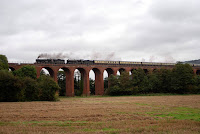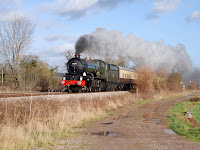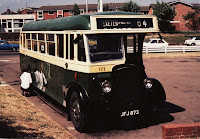 Above: Painting by Ian Cook Cock o’ the North on the Forth Bridge in watercolour and gouache.
Above: Painting by Ian Cook Cock o’ the North on the Forth Bridge in watercolour and gouache. John has sent in this wonderful contribution that I’m sure everyone will enjoy:
 The photos were taken by my friend Ian Cook who is making his name as a railway artist. I have seen some of Ian’s paintings and you can almost catch a whiff of that unmistakeable smell of smoke, steam and hot steam oil.
The photos were taken by my friend Ian Cook who is making his name as a railway artist. I have seen some of Ian’s paintings and you can almost catch a whiff of that unmistakeable smell of smoke, steam and hot steam oil.
The locomotive is LNER no. 2001 Cock ‘o the North, Gresley P2 class 2-8-2, a very powerful machine indeed.
Doubtless you recognise the location  – it is, of course, the mighty Forth Bridge in Scotland. Sadly none of the P2 class were saved although the enthusiasts have begun to build new. The Peppercorn pacific Tornado no. 60163 is the first of these new generation locos and because it uses modern construction techniques like a welded boiler and roller bearings in place of white metal journals, is proving itself a great mainline contender.
– it is, of course, the mighty Forth Bridge in Scotland. Sadly none of the P2 class were saved although the enthusiasts have begun to build new. The Peppercorn pacific Tornado no. 60163 is the first of these new generation locos and because it uses modern construction techniques like a welded boiler and roller bearings in place of white metal journals, is proving itself a great mainline contender.
As Ian is nearing retirement from his career as a sales engineer (for which he travels Britain and Europe) we must hope that his talent burgeons as he will soon be able to give himself totally to his art. Ian is no longer a railway modeller but is concentrating on railway photography and art. At present he is working on a painting of the Royal Albert Bridge, Saltash, the last great work of that doyen of railwaymen, Isambard Kingdom Brunel. Ian’s painting is being done in the golden light of an Autumn sunset. This bridge joins Cornwall to England. Perhaps I should tell you that the Cornish consider themselves a race apart and are as elite and separate as the people of Wales.

His photos that I sent you were in fact taken at Pontrilas, just over the border into Welsh Wales coming south from Hereford on the Welsh Marches line from Shrewsbury via Church Stretton, Ludlow, Leominster, Hereford, Pontrilas and Abergavenny to Newport (Monmouthshire). At Pontrilas the line crosses a shoulder of The Black Mountains, links up with the Great Western main line at Newport and then heads into Cardiff.
The sole locomotive in the photos is King class no. 6024 King Edward I shortly to be withdrawn for overhaul. But never fear because no. 6023 King Edward II is nearing completion of a total restoration so our heritage trains will not be bereft of a King for long.
The double headed train seen crossing the viaduct and at the lineside at Pontrilas is hauled by Kinlet Hall no. 4936 (not Hagley Hall no. 4930) and Nunney Castle no.5029.
There is one other King saved and that is no. 6000 King George V. It is kept in the ‘Steam’ museum at Swindon along with no. 4073 Caerphilly Castle. Sadly both are static exhibits and will not run again. It was no.6000 which, when new in 1927 was exhibited at The Baltimore and Ohio railway in the USA. The American engineers found it quite unbelievable that a locomotive which was dwarfed by theirs could be so powerful and free running. King George V was therefore presented with an inscribed brass bell which even today is bolted in position on the front buffer beam. If there is anything else you want to know about the railways, locomotives and rolling stock of Britain please feel free to ask. If I don’t know all the answers, I know a man who does!
 There are about eight Halls still running or in overhaul and about six Castles. All will run from time to time when in possession of a boiler certificate. Steam locomotive operation on “Heritage” trains with fare paying passengers on board is a tremendous business now here in the UK. British Rail have realised the earning potential of steam trains and all the old barriers to operation by restored steam have been dropped.
Ian used to own the heritage Daimler bus pictured here.
There are about eight Halls still running or in overhaul and about six Castles. All will run from time to time when in possession of a boiler certificate. Steam locomotive operation on “Heritage” trains with fare paying passengers on board is a tremendous business now here in the UK. British Rail have realised the earning potential of steam trains and all the old barriers to operation by restored steam have been dropped.
Ian used to own the heritage Daimler bus pictured here.
Share this with your friends on Facebook and Twitter. Use the buttons below.
Recommend model train ebook.
 The photos were taken by my friend Ian Cook who is making his name as a railway artist. I have seen some of Ian’s paintings and you can almost catch a whiff of that unmistakeable smell of smoke, steam and hot steam oil.
The photos were taken by my friend Ian Cook who is making his name as a railway artist. I have seen some of Ian’s paintings and you can almost catch a whiff of that unmistakeable smell of smoke, steam and hot steam oil. – it is, of course, the mighty Forth Bridge in Scotland. Sadly none of the P2 class were saved although the enthusiasts have begun to build new. The Peppercorn pacific Tornado no. 60163 is the first of these new generation locos and because it uses modern construction techniques like a welded boiler and roller bearings in place of white metal journals, is proving itself a great mainline contender.
– it is, of course, the mighty Forth Bridge in Scotland. Sadly none of the P2 class were saved although the enthusiasts have begun to build new. The Peppercorn pacific Tornado no. 60163 is the first of these new generation locos and because it uses modern construction techniques like a welded boiler and roller bearings in place of white metal journals, is proving itself a great mainline contender. There are about eight Halls still running or in overhaul and about six Castles. All will run from time to time when in possession of a boiler certificate. Steam locomotive operation on “Heritage” trains with fare paying passengers on board is a tremendous business now here in the UK. British Rail have realised the earning potential of steam trains and all the old barriers to operation by restored steam have been dropped.
Ian used to own the heritage Daimler bus pictured here.
There are about eight Halls still running or in overhaul and about six Castles. All will run from time to time when in possession of a boiler certificate. Steam locomotive operation on “Heritage” trains with fare paying passengers on board is a tremendous business now here in the UK. British Rail have realised the earning potential of steam trains and all the old barriers to operation by restored steam have been dropped.
Ian used to own the heritage Daimler bus pictured here.















